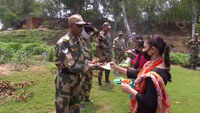India makes a renewed push for China to complete troop disengagement
India made a renewed push for China to complete troop disengagement at Pangong Tso and Gogra areas as well as pullback from the Depsang Plains in eastern Ladakh during top-level military talks between the two countries on Sunday. There was no official word on the outcome of the fifth round of talks between 14 Corps commander Lt-General Harinder Singh and South Xinjiang Military District chief Major General Liu Lin, which began after 11am and continued till late in the night on the Chinese of the Chushul-Moldo border personnel meeting point. But the talks were held amid the continuing Chinese refusal to even disengage fully on the north bank of Pangong Tso as well as Patrolling Point (PP)-17A at Gogra, let alone begin de-escalation and eventual de-induction of the over 30,000 troops each amassed by both sides along the Line of Actual Control (LAC) in eastern Ladakh. Consequently, India’s quest for restoration of status quo as it existed in April is still nowhere on the horizon. “The military talks seem to be going nowhere, with the People's Liberation Army (PLA) refusing to fully adhere to the disengagement process finalized during the fourth round of talks on July 14. Higher political-diplomatic intervention may be needed,” said an official. The PLA has been particularly adamant about not withdrawing eastwards from the 8-km stretch it has occupied from 'Finger-4’ to 'Finger-8’ (mountainous spurs jutting into the lake) after building scores of new fortifications and gun positions on the north bank of Pangong Tso since early-May. India contends the PLA, which initially withdrew from the ‘base’ of Finger-4 but did not vacate the ridgeline there, must pull back all the way to 'Finger-8’ since the LAC runs north to south there. But Chinese ambassador to India Sun Weidong openly rejected this just four days ago, claiming "China's traditional customary boundary line is in accordance with the LAC” on the north bank of the lake.
 01:43
01:43 02:34
02:34 02:10
02:10 01:40
01:40 01:50
01:50